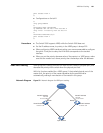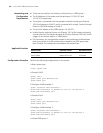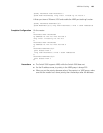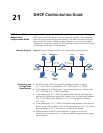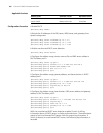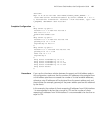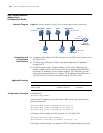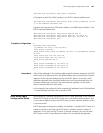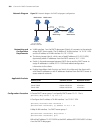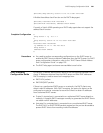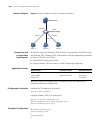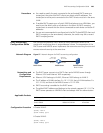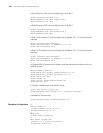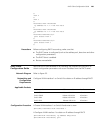
DHCP Relay Agent Configuration Guide 199
[SwitchA-Vlan-interface1] dhcp select interface
# Configure a static IP-to-MAC binding in the DHCP interface address pool.
[SwitchA-Vlan-interface1] dhcp server static-bind ip-address 192.168
.0.10 mac-address 000D-88F7-0001
# Specify the lease duration, DNS server address, and WINS server address in the
DHCP interface address pool.
[SwitchA-Vlan-interface1] dhcp server expired day 10
[SwitchA-Vlan-interface1] dhcp server dns-list 192.168.0.20
[SwitchA-Vlan-interface1] dhcp server nbns-list 192.168.0.30
[SwitchA-Vlan-interface1] quit
Complete Configuration #
interface Vlan-interface1
ip address 192.168.0.1 255.255.255.0
dhcp select interface
dhcp server static-bind ip-address 192.168.1.10 mac-address 000d-88
f7-0001
dhcp server dns-list 192.168.0.20
dhcp server nbns-list 192.168.0.30
dhcp server expired day 10
#
dhcp server forbidden-ip 192.168.0.10
dhcp server forbidden-ip 192.168.0.20
dhcp server forbidden-ip 192.168.0.30
#
Precautions After all the addresses in the interface address pool have been assigned, the DHCP
server looks up IP addresses from the global address pool containing the network
segment of the interface address pool for the DHCP clients. As a result, the IP
addresses obtained from the global address pool and those obtained from the
interface address pool are not on the same network segment, so the clients
cannot communicate with each other.
In this example, the number of clients requesting IP addresses from VLAN-interface
1 is recommended to be less than or equal to 250.
DHCP Relay Agent
Configuration Guide
Since some DHCP packets are broadcast, DHCP is only applicable to the situation
where DHCP clients and the DHCP server are in the same network segment, that
is, you need to deploy at least one DHCP server for each network segment, which
is not economical.
DHCP relay agent is designed to address this problem. It enables DHCP clients in a
subnet to communicate with the DHCP server in another subnet to obtain IP
addresses. In this way, the DHCP clients in multiple networks can use the same
DHCP server, which is cost-effective and allows for centralized management.



